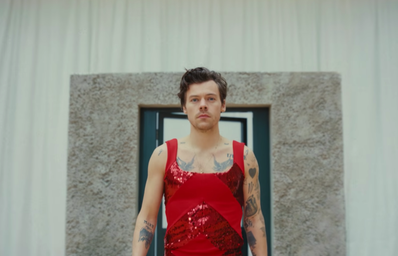Two years ago, Harry Styles made Vogue history as the first solo male cover star and did so in a dress. The cover has been touted as “revolutionary” because it normalizes gender-fluid fashion. Styles received a lot of positive feedback for this “ground-breaking” move. But, it’s not ground-breaking at all.
David Bowie was in drag for his “Boys Keep Swinging” music video 43 years ago. Queen was in drag for their “I Want to Break Free” music video 38 years ago. The concept of gender fluidity is not new to fashion or pop culture because of queer pioneers. The Vogue cover is not simply an issue of needing to credit who did it first, but rather an issue of Styles receiving praise for hopping onto a trend created by a community he does not claim. In reference to dressing in women’s clothing, Styles “never thought too much about what it means.” His position as a straight-passing man makes it possible for him to be ignorant of the community that developed this form of expression.
While he admits to drawing inspiration from queer artists like Prince, David Bowie, Freddie Mercury and Elton John, he fails to speak on what these “showmen” all have in common. Despite maintaining a relatively apolitical stance, Styles has become a symbol of rejecting gender conformity. This platform could have gone to a more vocal, politically invested, openly LGBTQ+ individual, had Vogue chosen to spotlight them. Styles is popularizing the aesthetics that queer people have cultivated while queer people themselves do not receive the same acceptance.
A few queer artists have questioned why Harry Styles is representing this conversation. Billy Porter criticizes Vogue’s decision saying, “all [Harry] has to do is be white and straight.” It’s interesting that Harry Styles would be chosen to be the face of the fight against “heterosexist dogma” considering the number of queer celebrities that have been doing that for decades without recognition. Billy Porter, an actor and singer well-known for his “eclectic” red carpet looks, was the first openly gay black man to be nominated and win in any lead acting category at the Primetime Emmys. Porter attributes his love of fashion to growing up in the black church and intentionally uses fashion to make political statements. He implies that Styles is just following trends of the times, saying, “[Harry] doesn’t care, he’s just doing it because it’s the thing to do. This is politics for me. This is my life.” Genderless fashion in general is a political statement because its sole purpose is to breach heterosexist standards and present an opportunity to express oneself fully. The concept’s recent mainstream acceptance has unfortunately devolved it into a little more than a fashion trend.
A common example is the use of the style to incur praise and not to seek true expression. Porter comments on Styles’ Vogue interview saying, “There’s always a frisson of eroticism around transgressing boundaries.” Straight men find it exciting to play dress-up and be sexually explicit and rarely receive hate for it. But when LGBTQ+ individuals dress nontraditionally, it becomes an issue. This contrast can be seen in the response Lil Nas X gets for breaking the heteronormative dress code. The rapper noted the hypocrisy tweeting that other artists “dedicate their entire music catalog to rapping about sleeping with multiple women but when I do anything remotely sexual I’m being ‘sexually irresponsible’ […] y’all hate gay ppl and don’t hide it.”
This disparity is not the fault of Harry Styles or Vogue, but the consequence of underlying homophobia and transphobia in pop culture and the general public. This prevents the true trailblazers from receiving recognition. Many of the icons I’ve mentioned lived through the 1980s during the height of the Acquired Immune Deficiency Syndrome (AIDS) epidemic and experienced this homophobia and transphobia firsthand. AIDS invoked stigma and thus negative attitudes toward those who had it, disproportionately homosexual men. It is contracted through behaviors that were already stigmatized, such as gay sex. It is contagious and it is incurable. This led to prejudice against gay men, and the gay community as a whole was ostracized. The “gay plague” was ignored by legislators because it was viewed as a homosexual disease. AIDS became the single greatest killer of men ages 25-44 in 1982 but was met with government silence. President Ronald Reagan did not publicly acknowledge AIDS until 1985, four years after the first official government report when 12,000 Americans had already died from the virus.
Those who lived through this era remember the lack of empathy gay people received and how they were viewed as sub-human. People would be characterized as gay based on the way they dressed and were ostracized accordingly. Harry Styles doesn’t have to “think too much about what it means” because it’s nothing more than clothes to him. Queer people continue to face discrimination for their fashion choices while straight men are labeled revolutionaries. This is one of the many reasons to recognize the sacrifices homosexual people made to develop a culture where people can be themselves. For those sacrifices to be watered down to the creation of gender-neutral fashion, of which Harry Styles is now the figurehead, is abhorrent.
I am not writing this article as a critique of Harry Styles, but rather as a critique of the systems that have made it somehow more palatable for a cis-gendered white man to be applauded as a pioneer of gender-nonconformity instead of gay, trans and non-binary individuals who have actually been driving the movement. Styles should not be a flag-bearer for gender-neutral fashion but we can still commend him for bringing these topics to light. Breaking fashion gender norms is synonymous with the LGBTQ+ community. Until we can recognize that and credit those who made it possible for Harry Styles to be on the cover of Vogue in a dress, we are not making as much progress as we pretend to be.
Want to see more HCFSU? Be sure to like us on Facebook and follow us on Instagram, Twitter, TikTok, YouTube and Pinterest!


